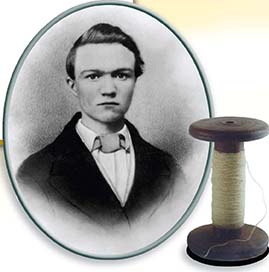SECTION 2: The Rise of Big Business

◄ Young Andrew Carnegie (far left) worked as a “bobbin boy,” winding cotton thread onto a bobbin like the one at left.
WITNESS HISTORY  AUDIO
AUDIO
From Rags to Riches
In 1848, 12-year-old Andrew Carnegie and his poverty-stricken family immigrated to the United States. He immediately began work in a Pennsylvania textile factory. Two years later, he got a job in a railroad office. By the time he was 40, he was a wealthy investor and the nation’s most successful steelmaker, famous for his commitment to innovation. Carnegie’s “rags to riches” story did not end with wealth. Believing that “the man who dies rich thus dies disgraced,” he established a number of charitable organizations in the United States and around the world.
Objectives
- Analyze different methods that businesses used to increase their profits.
- Describe the public debate over the impact of big business.
- Explain how the government took steps to block abuses of corporate power.
Terms and People
- corporation
- monopoly
- cartel
- John D. Rockefeller
- horizontal integration
- trust
- Andrew Carnegie
- vertical integration
- Social Darwinism
- ICC
- Sherman Antitrust Act
NoteTaking
Reading Skill: Identify Supporting Details Record supporting details about the rise of American big business in a chart like this one.

Why It Matters The rapid industrial growth that occurred after the Civil War transformed American business and society. Yet it was only the beginning. The rise of big business, characterized by the investment of huge amounts of resources, turned the United States into one of the most economically powerful countries in the modern world. Section Focus Question: How did big business shape the American economy in the late 1800s and early 1900s?
Fighting for Profits
Until the mid-nineteenth century, most businesses were run by one person or family. This meant that no business could grow bigger than one family’s ability to invest in it or run it. Businesses were also local, buying and selling to customers who lived nearby. Industrialization changed all this. Railroads provided businesses with access to raw materials and customers from farther and farther away. Business leaders, lured by the profits offered by these larger markets, responded by combining funds and resources.
The Corporation Develops
To take advantage of expanding markets, investors developed a form of group ownership known as a corporation. In a corporation, a number of people share the ownership of a business. If a corporation experiences economic problems, the investors lose no more than they had originally invested in the business. The corporation was the perfect solution to the challenge of expanding business, especially for risky industries such as railroads




